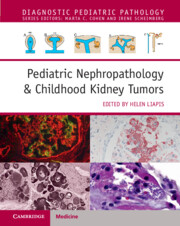Book contents
- Pediatric Nephropathology & Childhood Kidney Tumors
- Diagnostic Pediatric Pathology
- Pediatric Nephropathology & Childhood Kidney Tumors
- Copyright page
- Dedication
- Contents
- Contributors
- Preface
- Section 1 Normal and Abnormal Human Kidney Development
- Section 2 Glomerular Diseases
- Section 3 Tubulointerstitial Diseases
- Section 4 Vascular Diseases
- Section 5 Infectious Diseases
- Section 6 Cystic Diseases
- Chapter 13 Autosomal Dominant Polycystic Kidney Disease and Autosomal Recessive Polycystic Kidney Disease
- Chapter 14 Tuberous Sclerosis Complex
- Chapter 15 Glomerulocystic Kidney (GCK) and GCK Disease (GCKD)
- Chapter 16 Nephronophthisis Complex
- Section 7 Solid Tumors of the Kidney
- Section 8 Transplant Pathology of the Kidney
- Index
- References
Chapter 16 - Nephronophthisis Complex
from Section 6 - Cystic Diseases
Published online by Cambridge University Press: 10 August 2023
- Pediatric Nephropathology & Childhood Kidney Tumors
- Diagnostic Pediatric Pathology
- Pediatric Nephropathology & Childhood Kidney Tumors
- Copyright page
- Dedication
- Contents
- Contributors
- Preface
- Section 1 Normal and Abnormal Human Kidney Development
- Section 2 Glomerular Diseases
- Section 3 Tubulointerstitial Diseases
- Section 4 Vascular Diseases
- Section 5 Infectious Diseases
- Section 6 Cystic Diseases
- Chapter 13 Autosomal Dominant Polycystic Kidney Disease and Autosomal Recessive Polycystic Kidney Disease
- Chapter 14 Tuberous Sclerosis Complex
- Chapter 15 Glomerulocystic Kidney (GCK) and GCK Disease (GCKD)
- Chapter 16 Nephronophthisis Complex
- Section 7 Solid Tumors of the Kidney
- Section 8 Transplant Pathology of the Kidney
- Index
- References
Summary
Genetic renal diseases account for an underestimated group of patients with chronic kidney disease (CKD) and end-stage kidney failure (ESKD). Nephronophthisis (NPH) and autosomal dominant tubulointerstitial kidney disease (ADTKD) are two forms of hereditary tubulointerstitial disease with variable genetic transmission, e.g., autosomal recessive in NPH and autosomal dominant in ADTKD, and different underlying mutations and pathophysiology, but similar renal morphology with non-specific tubular atrophy and interstitial fibrosis as the most prominent features. NPH is a ciliary disease belonging to the NPH-related ciliopathies (NPH-RC) with currently more than 90 known genes, affecting primarily children and adolescent patients where it represents the most common cause of ESKD. ADTKD affects mostly adults and can be divided into five major forms with specific associated gene mutations leading to misfolded proteins that confer altered tubular energy supply and protein trafficking. Both diseases are associated with a poor renal prognosis and lack specific treatment.
Keywords
- Type
- Chapter
- Information
- Pediatric Nephropathology & Childhood Kidney Tumors , pp. 290 - 298Publisher: Cambridge University PressPrint publication year: 2023



